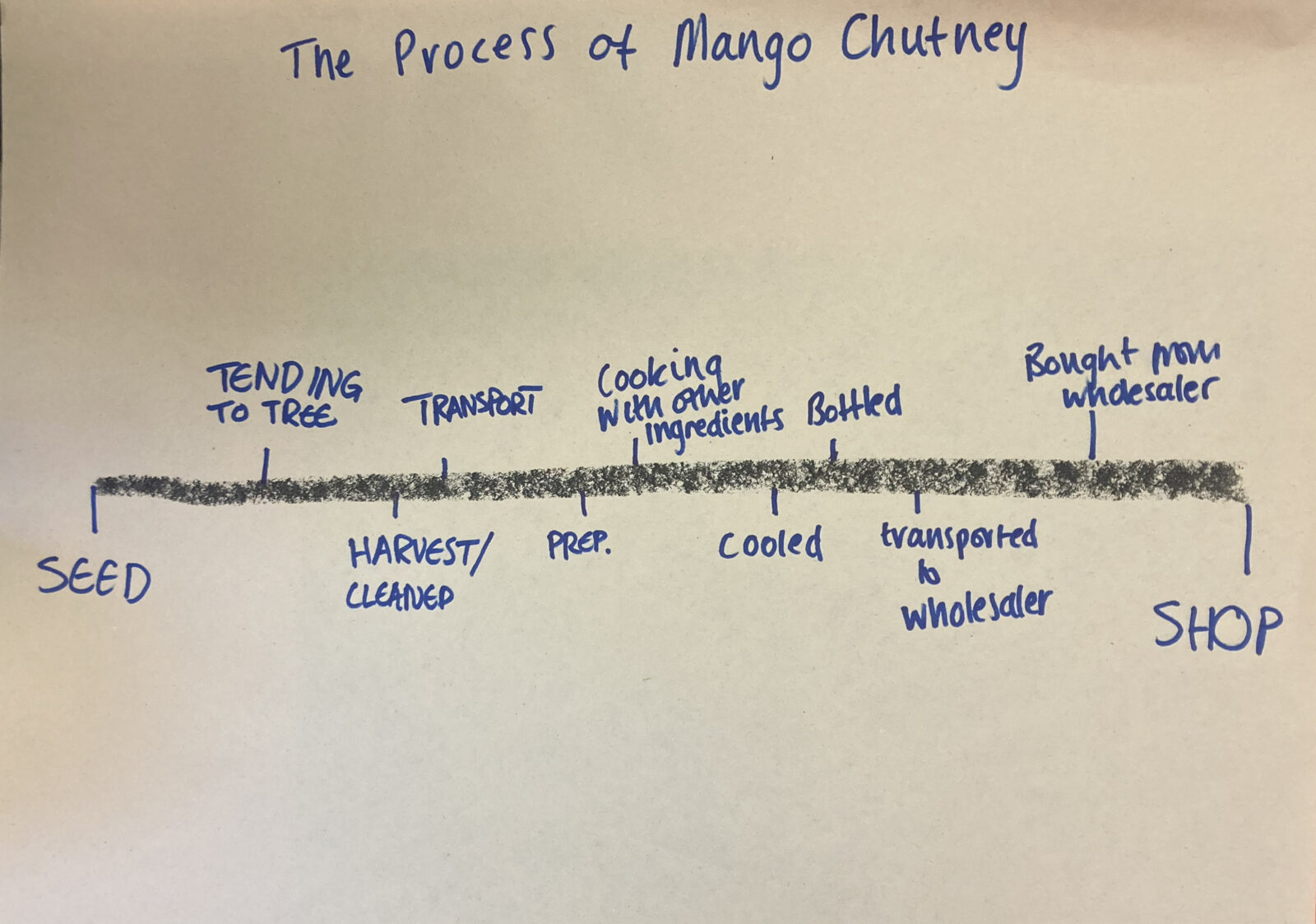By Ragini Chawla –

Hussein (Mitha) and I started the project with an intention to collectively think about the emotional, political and environmental aspects of the Mango – a fruit that is widely loved in Govanhill. For this project Rumpus Room has collaborated with Uronto, an artist-led open collective in Bangladesh. The collaboration is special, not just as Bangladesh echoes a frenzy for mangoes but also because Bangladesh is a leading producer and exporter of the many varieties of mangoes. We have been ever grateful to the community at Rumpus Room and at Uronto that brought together really important insights, some of them being facts, some of them being oral memories, stories and seeds of knowledge, and a lot of humour too around mangoes.

The first session, facilitated in person at Rumpus Room HQ and online with the Uronto community, saw participants engaged in sharing different mango stories. One of them had a mango thief – we visualised many faces – hands covered in a deep yellow smear of the mango. One of them highlighted memories of a time when mangoes were cheaper to access – imagine cartons stacked high outside several shops at Allison Street for just a fiver each. It was interesting to see that almost all participants in Bangladesh had stories related to picking mangoes directly from a tree in their neighbourhood, or being chased by an adult for taking mangoes from ‘their tree’. Many of them had experienced the growth of a mango tree, lived with one or stolen from one!

In contrast, Glasgow’s experience of attaining mangoes is detached from the tree, or the hands that grow the trees. So in the next session we wanted to look at the labour that goes into growing mangoes, importing them as well as using mangoes to make products.
On one of Glasgow’s sunnier days, we decided to meet around tables in the Rumpus Room yard under a gazebo. We had a bottle of Regal Spires Finest Mango juice, a carton of Honey Mangoes, a can of Maharajah mango slices and a jar of mango chutney on the table, as products to study the labour that went into their production.

Knowledge and facts weren’t the intended outcome here, reflection and imagination was. And so a group of three participants decided that it might take 3 years of labour + time to grow mangoes from a tree, while another group traced the journey from seed to shop of the mango chutney. It eventually got too warm to sit outside, and we all moved inside for reflection and sharing different varieties and products made from mangoes. As was the ritual at the end of every session.

Sadya, who founded Uronto, shared with us a physical copy of a book with extensive research on Mangoes, written by Mahbub Siddiqi. In our meetings with Sadya she had often told us anecdotes from the books, and we were excited to receive this for the Rumpus library. We’re grateful to Samaawat Khan, a young OSCH changemaker who agreed to translate some sections of the book from Bengali to English. A selection from the translated version is as follows:
‘Mangoes have got thousands of species and each has an exotic name. Sometimes they are named after the people who cultivated that particular species; for example, Fasli is named after Fasli Bibi of Bihar. The person who created the langra species of mango was unable to walk, and it was named the langra mango because of his disability (“langra” in Bangla refers to someone who, for whatever reason, is disabled and cannot use their legs). Similarly, Alfonso, Anwar Rataoul, Mohammadwala, and Jahangir are all named after people.’

Ragini met with the Uronto community over Zoom for another session where the community made zines. The book on mangoes was taken as a starting point in this session – and we focussed on creating zines as an accessible form of dissemination of the huge amount of research that the book explores. Each zine explored a very small section of the book adorned with illustration and humour of the Uronto community. The session ended with a very fun sharing of the zines.

At Rumpus Room, we were slowly approaching the annual Mango party, which is usually a smaller, more informal affair, but we were able to go all out on this year. The session preceding the party was consumed with painting mangoes and large signs on large cardboard pieces, and making games and plans for the party.

The celebration of mangoes, our project and the Govanhill community was adorned as a collaborative celebration with the support of the young participants of the workshops, Imran Bhai, Kelvingrove OSCH changemakers, food by Parveen’s and mangoes from Allison Street. The celebrations were also added to the Refugee Festival Scotland programme, fitting well with their 2023 theme ‘Hope’.

We were also really fortunate to be joined by Tanvir, who facilitated a quieter space and a collage making session during the mango party. Subsequently, Tanvir has further contributed to the project with his knowledge about mangoes in Bangladesh and his creative ways of facilitation.

As a final outcome of the project we created a poster series based on images created in the last session, and at a later workshop at Tramway. This last workshop was hosted as part of the programme surrounding Jasleen Kaur’s exhibition Alter Altar. We are hoping to hang these around Govanhill, as reminders of the intersections between heritage and climate change, between food memories and current labour conditions, between the past and the present. They will also be exhibited in Bangladesh, at Uronto.

If you are in any of these images and would like them to be removed, please email us.
The ‘Sticky, Luminous Fruit for All!’ project was brought to life in collaboration with the British Council led OSCH project.

